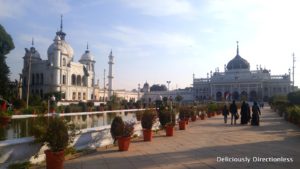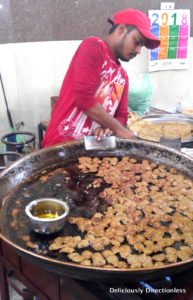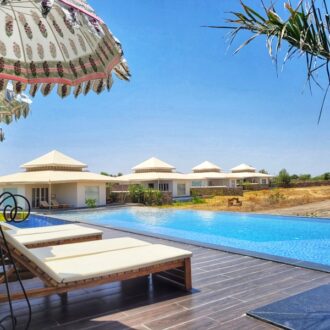
Lucknow, known as the City of Nawabs, is famed for its tehzeeb or cultured refinement. Add to this a rich history and an even richer cuisine, and you have a holiday destination that ticks all the boxes.

My tour guide summed it up well; “Lucknow is the city of Nawab, kebab, and shabab (beauty)”. Here’s how to take it all in if you have limited time in the capital of India’s most populous state.
Morning

Begin your day with a cup of chai and bun maska (buttered bun) at Sharmaji ki Chai in the Lalbagh area of the city.

Alternatively, visit Bajpai Kachori Bhandar at Hazratganj, which serves scrumptious poori-kachori with a side of spicy potato & chickpea sabzi.

With a full belly, it’s time to head to Lucknow’s most iconic attraction. Asaf-ud-Daula, the fourth Nawab of Awadh, built the Bara Imambara complex in 1784. The colossal imambara (sacred hall built for the mourning of Muharram) has a stunning Mughal-style decorative architecture.

The pistachio-coloured central hall is massive and is said to be the largest arched hall in the world.

The most striking feature of the imambara is the bhul bhulaiya or labyrinth upstairs. It’s easy to lose your way in this maze of tunnels so it’s better to hire a guide who can show you around.

From the terrace, you can get a spectacular view of the city and the imambara complex, which has a large landscaped garden, a step-well, and the rather attractive Asfi mosque.

Mid-morning
Just outside the imambara complex is another must-see monument, the Rumi Darwaza. The imposing, highly ornamental Awadhi style gateway also dates to 1784. It marked the entrance to the old city. The name Rumi refers to the Roman Empire and the gateway was modelled on the ancient gates of Constantinople, then the capital of the Eastern Roman Empire. A busy arterial avenue passes through this gate, so be careful when you’re taking photos here!

A 10-15 minute walk from Rumi Darwaza will bring you to the Chota Imambara, an elaborately carved and decorated monument that serves as a congregation hall. It is also the mausoleum for Muhammad Ali Shah, who had it constructed in 1838.

The ceremonial hall is beautifully decorated with chandeliers brought from Belgium in all shapes, sizes, and colours.
Afternoon
It’s time to rest your feet after all that walking around, and what better way to do that than to tuck into a delectable lunch at the stunning blue-and-turquoise Azrak restaurant at Lebua Lucknow. The restaurant offers traditional Awadhi cuisine resurrected from the age-old recipes of the Nawab’s royal kitchens. Feast on an array of kebabs, nihari (a flavourful stew with tender goat meat), biryani, and more.
Next, head to Seva Chikan to see Lucknow’s famed chikan embroidery work in action. You can drop in at the workshop and watch women making delicate and intricate patterns with white thread on white or pastel coloured muslin cloth. The adjoining shop is a great place to pick up chikan dress materials, saris, and dupattas.
This is also a good time to drop in at La Martiniere College, the city’s premier educational institution housed in an extravagant French colonial-style building set amidst a sprawling campus.
Evening
Lucknow probably has the best street food culture in India, which really comes alive in the evening.

Start with Shukla Chaat House, a hole-in-the-wall stall in Hazratganj that opens for business only at 4 p.m. It is one of the oldest chaat houses in the city. Try the aloo tikki chaat (potato patties smothered with chutneys and spiced yoghurt) and matar chaat (green peas patties).

Then, head to the Chowk area to Raheem’s for lip-smacking nihari and hot-off-the-tandoor kulchas.

Not too far away is Idrees Biryani, where the biryani is delicately flavoured and not very heavy-handed with the spices.

Round off the meal at Ram Asrey in Chowk, a sweetshop that has been around since 1805. Here you can get a taste of Lucknow’s special malai ki gilori, a soft triangle made with sweetened layers of milk cream folded together.
Night
Like most major Indian cities, Lucknow continues to be vibrant until the wee hours. Many of the city’s attractions acquire a different aura when the sun goes down and the lights come on. Head back to Rumi Darwaza to see how the incandescent light casts a beautiful glow on the gate’s architecture. Try taking long exposure photographs here with cars weaving in and out of the gate, their taillights glowing.
The Gomti Riverfront Park is a great place for a stroll (the park closes at 10 p.m.).

And for a late night snack, head to the one and only Tunday Kebabi (open until 11 p.m.). While many kebab stalls now use the name of ‘Tunday’, the original shop opened in the Chowk area way back in 1905. Since then, it has been serving succulent, absolutely melt-in-the-mouth buffalo meat Galauti kebabs. The kebab contains no fewer than 160 different spices and the recipe is a closely guarded secret. Watch the shop in action in the video (plays sound) below.
Where to stay in Lucknow


If you decide the spend the night in Lucknow, I highly recommend the boutique hotel, Lebua Lucknow, the only heritage hotel in the city. This pristine white Art Deco bungalow from the early 1900s has been lovingly restored into a luxury hotel that blends old-world charm with modern hospitality.


Have you visited Lucknow? What was your favorite thing to do? Leave us a comment below.
This article appeared in the July 2018 issue of Go Air’s Gogetter magazine. Read it here.




Is it true that you can be heard on other side of walls inside bhool bhulaiya?
Yes, it’s true!
what a yummy and delicious post it is..
Thanks!
Hi Prachi,
Wonderful Blog. I really enjoyed reading it. The photos are very beautiful. I just can’t stop myself from looking at these food photos. Thank you for sharing this amazing blog.
Thank you, glad you liked it!